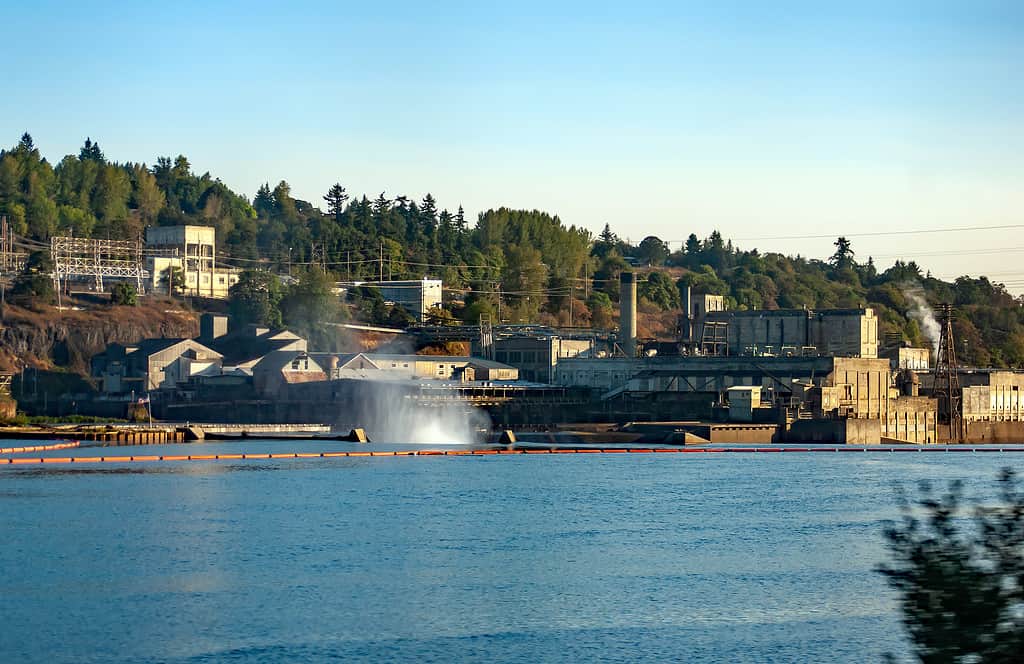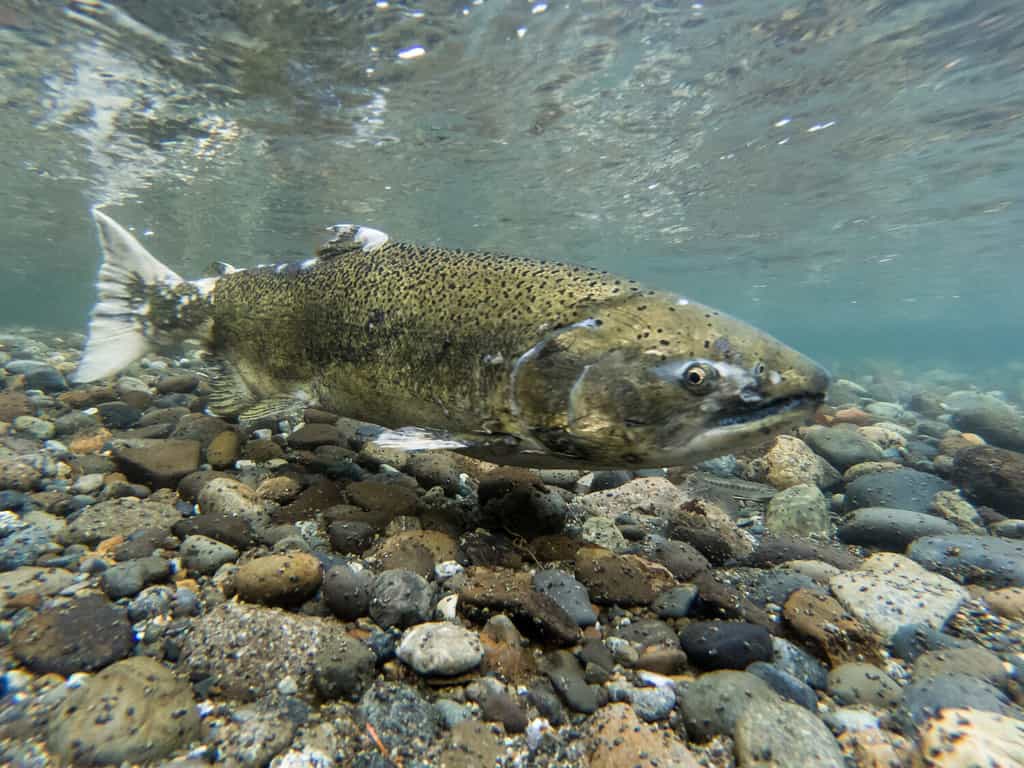The Willamette River is the 13th largest river by volume in the United States and a large tributary of the Columbia River. It is also the home of the second-largest waterfall by volume in the United States. This incredible river flows mainly through northwestern Oregon and has an overall length of 187 miles. Passing through Portland, Eugene, and the state capitol, Salem, the river is the site of rich human history and even richer plants and animal ecosystems.
Depth of the Willamette River

The Willamette River reaches a maximum depth of 126 feet.
©MrsPeacock/Shutterstock.com
We spoke with Chris Prescott at the Portland Bureau of Environmental Services, who verified that the maximum depth of the Willamette River is about 126 feet. This point is located above Hog Island and below Lake Oswego. We also took the time to scour the depth maps at USA Fishermaps to verify this information ourselves. Its widest point reaches a width of around 2,000 feet. Since it doesn’t leave Oregon, it also gets the title of the largest watershed in the state. The river flows south to north until it meets the Columbia River near Portland, Oregon.
70 percent of Oregon’s population lives in the Willamette Valley, and most of these residents need only drive 20 minutes to get to the shore. One of the purest lakes in the world, Waldo Lake, is a key water source for the river. This massive river makes up 12-15 percent of the entirety of the Columbia River’s annual flow. Interstate 5, a highway that runs north to south through several states, follows the river in its entirety.

History
Formed over 35 million years ago, the Willamette River has many stories to tell. Several major climate events have impacted the size and shape of the river, including the Missoula Floods over 10,000 years ago. These floods, a result of periodic sudden ruptures of the ice dam on the Clark Fork River, are deeply responsible for the current condition of the river. This river became a major destination for pioneers on the Oregon Trail, as it made the lands surrounding it rich with nutrients. Blessed with rich soil and high fertility, the entire Willamette Valley benefits from the presence and movement of the river.
With all of this history in mind, it is no wonder that the area surrounding the river is the most populated part of the state. Unfortunately, there are a series of faults under the river and its basic, making the area more prone to earthquake activity.
The Naming of the Willamette River
The original name of the Willamette River is Santiam River. This is after the Santiam people, part of the Kalapuyan tribe that inhabited the area. The name Willamette is a derivative of the word “Wallamt”, an indigenous word meaning either “still water” or “spill water”. Other sources state that the original word means “west bank”. Regardless, the new name of the river is the result of an attempt to pay homage to the Indigenous peoples that inhabited and cared for the land prior to the arrival of European settlers.
The Founding of Portland

Portland would not be the thriving city it is today without the Willamette River.
©Steve Morgan / Creative Commons – License
It is true that Portland would not be the thriving city it is today without the Willamette River. In 1843, two business partners, William Overton and Asa Lovejoy, filed a claim for land along the west bank of the Willamette. This land claim would result in the incorporation of Portland in 1851, following its 1845 naming.
The Chinook people inhabited the land prior to the development of Portland. Two separate tribes, the Multnomah and the Cascade peoples, used the area for fishing and foraging and built several villages along the shores of the Willamette River. Both of these native tribes experienced decimation at the hands of disease brought by European settlers. With native tribes mostly eliminated, Europeans were free to settle the land.
Portland, Oregon gets its name from a homage to Portland, Maine. William Overton sold his half of the land claim to Francis Pettygrove, who hailed from Portland, Maine. In a coin toss, he won the right to name the city. Previous to this naming, Portland went by a different title – “The Clearing”.
The city now boasts a population of over 640,000 people.
The Founding of Salem
It is important to note the founding of Salem, Oregon, as well. The state’s Capitol rests on the banks of the Willamette River and has a history tied to its flow. Located in the heart of the Willamette Valley, Salem’s original name was Chemeketa. This is a native Kalapuya word from the Santiam language meaning “place of rest”. Europeans settled and developed it in 1844. Salem became the official state Capitol by popular vote in 1864. Salem does not get its dominant amount of drinking water from the Willamette, but the river still plays an important role in the development and success of the city.
The city remains the Capitol City of Oregon to this day and boasts a population of over 177,000 people.
Willamette Falls
Willamette Falls is an extremely impressive waterfall along the Willamette River. In the United States, it is the second-largest by volume, only surpassed by Niagara Falls. In the northwestern United States, it is the largest by volume. This waterfall also makes the top 20 in the world for width, placing 17th with a maximum width of 1,500 feet!
The falls bear great cultural significance for the remaining native tribes in the area. Native oral history describes the falls as a gift from Coyote, who placed the falls to ensure that the tribes living in the area would have ample fish to eat all year round. The Willamette Valley Treaty of 1855 initiated the forced removal of remaining tribal members from their ancestral lands. This removal relocated surviving tribes to two separate Reservations, leaving the lands surrounding the waterfall open for development.
Despite this removal, members of many tribes originating in the area still fish the waters. Tribal members conduct yearly ceremonial salmon harvests along the river and the falls. The traditions of these people extend far past European settlement and stand strong in the face of opposition. Willamette Falls continues to be an important part of the culture, heritage, and history of these people.
Wildlife in the Willamette River

In the aquatic riparian areas, such as springs and streams, you can find Chinook salmon.
©Kevin Cass/Shutterstock.com
The Willamette River is an important and diverse riparian habitat. This river creates a variety of important natural habitats, from aquatic riparian to oak woodlands. Since the habitat diversity ranges so much along the river and in the Willamette Valley, so do the species who live there.
In the aquatic riparian areas, such as springs and streams, you can find Chinook salmon, Pacific lamprey, and Northern red-legged frogs. These areas also contain bullfrogs, bull trout, and sand rollers. In the wetlands and marshes, many other species thrive. These include the Canada goose, western painted turtle, blue heron, and belted kingfisher.
In oak woodlands and shrubbery, look for the presence of white-tailed deer, brush rabbits, northern pygmy owls, rubber boas, red foxes, and black-tailed jackrabbits. In grasslands, the western burrowing owl makes its home alongside animals such as the vesper sparrow, common nighthawk, and the deer mouse. Looking toward the massive legacy trees of the area, the American kestrel makes its home in ponderosa pines and other similar forests. This is also where bobcats and barn owls thrive.
As you can see, there are several different critters that call the Willamette River and surrounding valley their homes, and we’ve only named just a few. Squirrels, raccoons, and black bears also inhabit the region, along with coyotes, bald eagles, and beavers. There is no shortage of wildlife along the span of this impressive river. Look to local resources and conservation for the best places to view and appreciate the wildlife of the area. You can also find lots of resources from the United States Department of Agriculture and their page on the Willamette National Forest.
Visiting the Willamette River
Visiting the Willamette River is a treat. With a variety of activities across several cities, you can find something that suits everyone. The Willamette Greenway and Water Trail extends 255 miles and includes several historical sites and state parks. This area is especially good for boating activities but also includes areas for swimming, hiking, and wildlife viewing.
The Willamette River is the region’s lifeblood, meaning there is frequent access to the water and recreation surrounding it. From guided paddles to riverside food trucks, boat launches to outdoor music venues, the area is rich with life and culture. Explore the vast history of the region or just take a moment to sit quietly by the water. Feeling adventurous? Head out to one of many incredible hiking trails along the river or stray into the valley for a climb up to one of the many summits.
For those who prefer cities and shopping, Portland, Eugene, and Salem all provide in excess. Lake Oswego is also excellent for this sort of exploration, boasting a variety of boutiques and fine dining experiences. For swimming, Portland alone has four different beaches and swimming areas along the river, such as Poet’s Beach and Audry McCall Beach.
Make sure to do your research before you go to ensure that you’re visiting at a good time of year and that the town or wilderness area you choose is ideally suited to your tastes.
The photo featured at the top of this post is © ESB Professional/Shutterstock.com
Thank you for reading! Have some feedback for us? Contact the AZ Animals editorial team.






